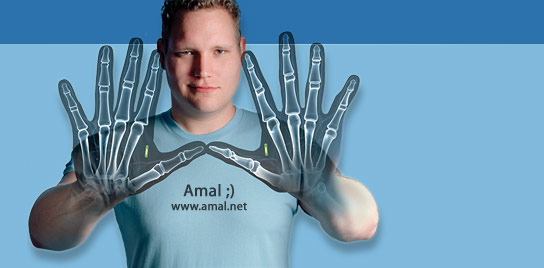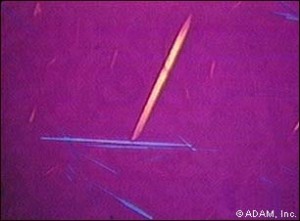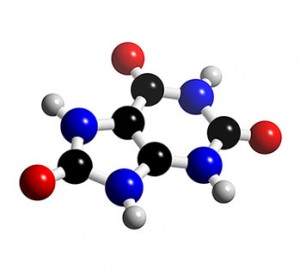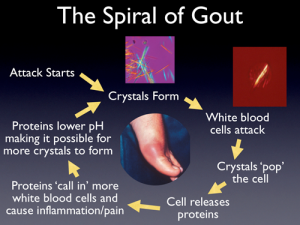Last May I posted about my adventures with gout and the things I was doing to try and fight off acute attacks. Well, since then I’ve had a couple tinglings of pain in various joints but had been able to avoid a full blown attack. Today I’m hobbled, unable to walk because my left ankle and big toe joints are inundated with needle-like crystals that cut up tissue and cause very painful inflammation.
Ever since the first time I had an acute attack, I’ve been scouring the Internet and talking to doctors trying to find out exactly what’s going on. All my discussions with doctors only turn up an NSAID prescription, and of course the Internet is boundless with it’s bullshit cures. I wanted to know just what the hell was going on and why it was affecting me so badly… I mean I wasn’t considered “high risk” because I didn’t drink alcohol or eat meats and other foods both doctors and crazy Internet sites said were common causes… but nobody could tell me much.
Today I reformed my query to the all knowing Internet and was greatly rewarded. Instead of taking a medical slant, I went with a biologist/biochemist approach. This immediately lead me to a much better explanation of what was going on and why. Below is the uric acid molecule:
The 3dchem.com page that details this molecule has the following to say (I’m copying the text for posterity):
Uric acid is a small organic compound which is produced by the breakdown of protein during digestion, is excreted by reptiles and birds. Xanthine oxidase oxidizes oxypurines such as xanthine and hypoxanthine to uric acid. In humans and higher primates, uric acid is the final oxidation product of purine catabolism. In most other mammals, the enzyme uricase further oxidizes uric acid to allantoin. Uric acid is also the end product of nitrogen catabolism in birds and reptiles. In such species, it is excreted in feces as a dry mass.
Humans produce only small quantities of uric acid, it is a strong reducing substance (electron donors) and potent antioxidant. In humans, about half the antioxidant capacity of plasma comes from uric acid.
Excess serum accumulation of uric acid can lead to a type of arthritis known as gout. Hyperuricemia, from the elevated level of serum uric acid can result from high intake of purine-rich foods, high fructose intake and/or impaired excretion by the kidneys. Saturation levels of uric acid in blood may result in one form of kidney stones when the urate crystallizes in the kidney. Some patients with gout eventually get uric kidney stones.
Formal Chemical Name (IUPAC)
1H-purine-2,6,8(3H,7H,9H)-trione
So! That’s the answer… Fructose! After looking at what I ate, the two things I found that could cause spikes in uric acid were 1) over consumption of food (eating too much), and 2) fructose (especially stuff containing high fructose corn syrup). If I think back, just about every time I got an acute attack was after at least a week long period where I was eating way too much in a day and downing sugary softdrinks made with HFCS.
I also found out most mammals also have an enzyme — uricase — for breaking uric acid down into a soluble product. However, during the evolution of great apes and humans, the gene encoding uricase became inactive. It would seem a predisposition to gout is our legacy… but what if we could simply inject uricase to help directly break down uric acid during an acute attack? Apparently one company was set to get FDA approval for just such a drug last year. Savient Pharmaceuticals created Krystexxa® (also called puricase or pegloticase), which got a 14 to 1 vote for approval by the FDA panel… but at the last second they rejected approval due to questionable manufacturing processes (source). That means, if they can get their act together, that there should be a uricase enzyme based drug approved in the next couple years.
Not to mention, uric acid is only slightly soluble in water and easily precipitates out of solution forming the dreaded monosodium urate crystals. Well I’ve been drinking tons of water like everyone (Internet BS, doctors, etc.) said will help flush it all out, but it seems that over-hydrating is basically futile. In fact, our kidneys reclaim most of the uric acid it filters from the blood and only passes a small amount in urine anyway. If your uric acid level is higher than 6mg/dL (333µmols/L), urate crystals will form regardless of the amount of water you drink because you simply can’t drink enough to thin your blood out without putting yourself in danger… and it would be a very temporary situation anyway as your body worked to get rid of the excess water. So we’re left with a barely soluble molecule that readily assumes a crystalline structure in water solution, and the kidneys don’t want to get rid of it anyway! Most animals like birds and reptiles that excrete uric acid do so through feces not urin. In fact, the white stuff in bird poop is mostly uric acid.
Anyway, this is all very encouraging. If you have issues with gout, but aren’t into all the biochemistry, there is one site that seems to be not that full of BS… it lists some very interesting things which I’m going to duplicate here since I’m unsure how long that site will be around now that his book seems to no longer be in print (get it while you can).
Act Fast!
Gout is caused by an immune response to uric acid crystals forming in the joint (see Gout Basics). This immune response starts a spiral that quickly causes massive inflammation and pain. The key to stopping a gout attack is to break the spiral!
If you interrupt this spiral, you can usually stop a gout attack in an hour or two.
The secret is to take medications to interrupt this cycle as soon as possible after you first notice symptoms. The sooner you act, the more successful this treatment will be. Don’t wait, not even for a minute. Gout attacks build quickly and the sooner you act, the easier it is to break this cycle before it spirals out of control!
Actually, one note I’d like to point out here about the “gout spiral”… the cytosol of most cells has a concentration of uric acid that is up to 100 times greater of that in extracellular fluid. So when uric acid crystals destroy tissue, the lethally-damaged cells release their contents and additional urate crystals immediately form in the vicinity.
Ok, back to the data duplication…
Not a DIY
This is the point where I have to stop for a warning. This site, my book, the internet in general are not “do-it-yourself” resources. Gout and the medications to manage gout can be dangerous if you don’t know what you are doing. So please talk to your doctor about any treatments before you take them – your life might depend on it!
First Line Drugs to Stop a Gout Attack
The most commonly prescribed drugs to stop gout attacks are Non-Steroidal Anti-Inflammatory Drugs (NSAIDs). These medications include indomethacin, naproxen and sulindac. There are several others that research has shown are just as effective but these three have been approved for this use on by the US Food and Drug Administration. You will also notice that naproxen is an over-the-counter drug that is found in Aleve® making it a good option if you are not at home when the attack strike (again, ask your doctor first!).
These medications are powerful drugs that block inflammation in the body. If you take them at a high dose, this will interrupt the spiral of a gout attack and will usually stop the attack in its tracks. But remember to talk to your doctor before taking any of these medications and stop taking them as soon as possible! If you have heart problems or stomach problems you are at the highest risk – be sure to tell your doctor!
NSAIDs Used to Stop Gout Attacks
* Indomethacin: Never take for more than 2 days and never take more than 200 mg/day unless directly instructed to do so by a doctor.
* Naproxen: Never take more than 750mg the first day and never take for more than ten days unless directly instructed to do so by a doctor.
* Sulindac: Never take more than 400mg a day and never take for more than seven days unless directly instructed to do so by a doctor.Other Medications to Stop Gout Attacks
If you have health problems that prevent you from taking NSAIDs to stop a gout attack, don’t worry, there are other options. The most common of these is colchicine. I am not a big fan of colchicine. I have made far too many trips to the bathroom as a result of taking this 4000 year old drug. Also, most doctors are still prescribing it at a high dose, even though a lower dose has been shown to be just as effective. However, over all, I do not think colchicine is anywhere near as effective as NSAIDs or any of the other options, but that’s just me opinion. There is no research that directly compares colchicine with NSAIDs or any other treatment. Another thing to watch out for is the fact that colchicine builds up in the body and is removed very slowly making it easy to overdose. It can become potentially fatal when you take more than 6mg for an attack (that’s just 10 – .6 mg tablets)!
Taking Colchicine:
* Take .5 or .6 mg of colchicine three or four times a day until pain subsides. Never take more than 6 mg of colchicine for an attack!
Other Options:
Again, as with all the other treatment, the sooner you get treated the more effective these treatments will be.
Corticosteroids: These can be taken orally, which is about as effective as NSAIDs. They can also be injected which results in much faster action and is probably the most powerful means of stopping an attack. Injected treatments need to be administered by a doctor.
ACTH: This is the synthetic version of a hormone secreted by the pituitary gland. This treatment has fallen out of favor recently, but new research shows that it is very effective. ACTH also needs to be injected.
Anakinra: One very small study recent found that this drug, which is used to treat rheumatoid arthritis, can be an effective medication for treating gout attacks. This medication is also taken orally which makes it a good option if none of the other treatment work for you or you cannot use them because of medical problems. However, more research needs to be done to prove its effectiveness with gout.
The Key to Stopping is Never Starting
Of course, the best way to stop the spiral of a gout attack is to prevent the spiral from starting in the first place. The only way to do this is to lower uric acid levels in your body. If uric acid levels are low, then this spiral can never get started. For most of us, high uric acid levels is a genetic problem (see, Gout Myths and Secondary Gout) and can only be effectively managed through uric acid lowering treatments.
Other good posts to check out are:
An actually good “top 10 gout myths” page (for once)
Gout and High Fructose Corn Syrup
Questions Being Raised About the Importance of Diet on Gout
Tags: health
















Gout sounds bad man, but at least you are learning some chemistry from it right? If you happen to find anything out mouth ulsars please pass it on… it seems to be a bullshit landslide every time I search for information online :/
The latest I’ve heard about ulcers is that they have a connection to bacteria that actually eat away at the stomach lining… so it’s not just acid or “stress” causing the problem. Even though those are contributing factors, a bacteria infection is a much more treatable situation.
http://www.sciencedaily.com/releases/2009/03/090322154405.htm
http://microbiology.suite101.com/article.cfm/what_causes_stomach_ulcers